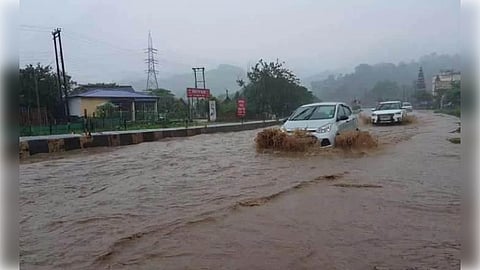
- Home
- NG Hindi
- India
- World
- Politics
- Sex & Relationships
- Entertainment
- Culture
- Lifestyle
- Economy
- Sports
- Sp. Coverage
- Misc.
- NewsGram Exclusive
- Jobs / Internships

Anyone who sincerely takes a bird’s-eye view of the areas around Jorabat (Meghalaya, India) cannot help but feel a deep sense of hopelessness. The lush green hills that once stood like proud forts of Meghalaya’s natural charm are now gasping for breath. Not just that, they are scarred, shrinking, and also weeping!
It seems that all these years, there has been no administrative authority willing to take a firm stand to protect our forests, safeguard our flora and fauna, and preserve our precious water bodies. The slow disappearance of these hills due to rampant earth-cutting, quarrying, and the construction of buildings in the name of development has begun to spell disaster.
This Sunday, on the 5th of October, a brief downpour lasting less than thirty minutes was enough to expose the fragility of our battered ecology. Like thousands of other commuters, my friends and I, while returning from Guwahati, were stranded for more than two hours due to a partial flash flood. It was a short spell of rain, yet the consequences were severe. I shudder to think what would have happened if it had rained continuously for five hours that day. On May 30–31, 2025, these areas received about 110 mm of rainfall within 24 hours, marking the highest May rainfall ever recorded, turning NH-27 near Jorabat into a flowing river and causing seven-hour traffic jams. Have we not heard countless people missing their flights and trains to Delhi, Mumbai, and Bengaluru because of these recurring flash floods? Is this highway not our only lifeline to the rest of the country? I dare say, this stretch of GS Road is the “central vein” of Meghalaya; when it clogs, the entire body gasps.
What struck me most was the nature of the floodwater. It was “thick with mud”—a clear sign that the soil is eroding with a vengeance. This is not just runoff; it is the land itself being washed away. If this continues unchecked for another five years, half of the hills we see today might be flattened. Sadly, our indifference and our silence are now deafeningly obvious. I wonder when we will finally wake up to this reality. Why are we not serious about the task of conserving soil, as many western countries are?
This habit of turning a blind eye to nature’s warnings isn’t just Meghalaya’s burden. In early August 2025, Himachal Pradesh and Uttarakhand got a brutal reminder that mountains don’t take kindly to neglect. Highways were ripped apart, villages buried, and hundreds of lives lost in a wave of flash floods and landslides. Himachal alone witnessed 97 flash floods, 45 cloudbursts, and 137 major landslides between June and September --leaving behind 378 deaths, 1,237 homes in ruins, 684 roads blocked, and water supply systems gasping for breath. Of course, Uttarakhand’s Uttarkashi district wasn’t spared either. A cloudburst on August 5 turned the landscape upside down, sweeping away buildings and infrastructure. At least five lives were confirmed lost, eleven army personnel went missing, and the rainfall? It clocked in at a jaw-dropping 421% above average—in just one day. When nature roars, spreadsheets and cement don’t stand a chance.
One aged school teacher from Jaintia Hills (Meghalaya) rues: “when will each of us truly realize that Meghalaya’s green hills were not at all meant only for visual delight which we can just do away with? They are ecological fortresses.” Yes, the teacher is absolutely right that these hills unmistakably act as “natural sponges”, absorbing rainwater, slowing its flow, and helping to rejuvenate underground aquifers. Hills with greener cover effectively prevent landslides, filter the air, and regulate the climate. Can any of our advanced technologies do that for us?
What is really frustrating is the fact, as reported, that between 2001 and 2024, Meghalaya lost close to 243,000 hectares of tree cover – a whopping 14% erosion of its forested landscape since 2000. Why has it still not dawned on us that the vitality of our urban spaces is sustained by the greenery that surrounds them? Without the hills, rivers, and green vegetation, the energy of our towns will be drained away.
Now we are left wondering: how do we restore what we have lost? How do we bring back the hills we have cut down? I believe we are now merely waiting to see the ecology throw its “ominous tantrum.” We are simply waiting to watch all the houses of poor people and the high-rises of Jorabat and Khanapara tumble down, just as it happened in Northern India. If we do not act now, I am pretty sure Mother Nature herself might stand up with a “hacksaw,” ready to cut our ambitions to size.
(NS)
Suggested Reading:
